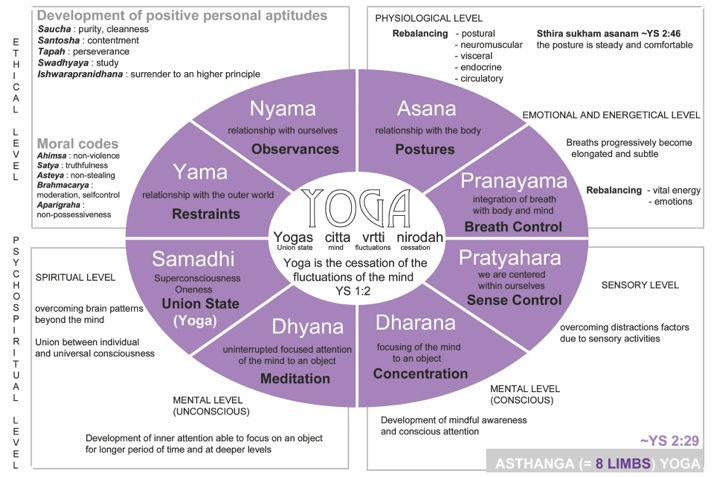When the word “yoga” is mentioned, most people think of physical poses for limbering the body and focused breathing to relax the mind. These aspects are only a small part of what yoga involves.
Traditionally, the term yoga refers to Raja Yoga, or the mental science of the mind. It includes Eight Limbs, which are considered as a progressive series of steps that purify the body, mind, and spirit. The primary text for this all-encompassing view is the Yoga Sutras of Pantanjali.
Sutra means thread; the sutras have the barest thread of meaning and are open to interpretation. Pantanjali, considered the “father” of yoga, first presented these teachings to his students orally, somewhere between 5000 BC and 300 AD. Various sages and scholars preserved them in writing, and during the centuries that followed, added their own commentaries.
The first two stages of the Sutras deal with morality and ethics. The next three focus upon discipline of the body and senses. Together, they form an external foundation. The last three stages are internal, and concern the function of the mind.
1. YAMAS, or restraints.
* Ahimsa, or non-violence. Harmlessness in
thought, word and deed. Compassion.
- Satya, or truthfulness. Being true to ourselves
and others. Authenticity. - Asteya, or non-stealing. Freeing ourselves from
desire for power, objects, or undeserved credit. - Brahmacarya, or continence. Exercising
self-control over all things sensual. - Agarigraha, or non-greed. Liberation from
material possessions. Simplicity.
2. NIYAMAS, or observances.
- Saucha, or cleanliness. External hygiene, as
well as a wholesome diet and pure thoughts. - Santosha, or contentment. An active appreciation
of personal circumstances. Equanimity. - Tapas, or effort. Strength of character;
willingness to devote self to transformation. - Svadhyaya, or study. Introspection; the study of
self and the study of scriptures and spiritual reading. - Ishvara-Pranidhana. Surrender to and worship of God.

3. ASANA, or the physical poses in hatha yoga.
Pantanjali considered the postures as a means to sit
quietly in meditation. His only direct reference to
these physical aspects was that they consist of two
factors: to remain steady and comfortable.
4. PRANAYAMA, or breath control. Prana means energy,
or our life force/breath, and yama means control.
5. PRATYAHARA, or sense withdrawal. Restraining the
mind from outside impressions in order to bring attention and focus inside.
6. DHARANA, or concentration. Giving sole attention to
one object, such as the breath or a mantra. To direct
and maintain that attention.
7. DHYANA, or meditation. The mind achieves a steady,
effortless flow of attention to the object of attention.
8. SAMADHI, or the state of self-realization. The
object meditated upon and the process of meditation
are merged and become one. Spiritual absorption.
https://www.youtube.com/watch?v=1Vp8sSHw1go





